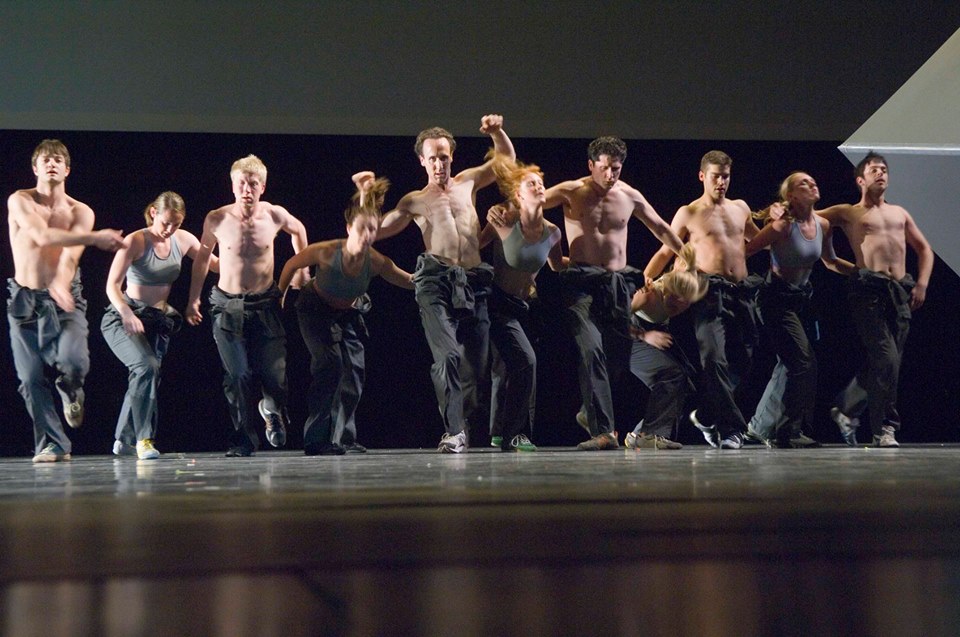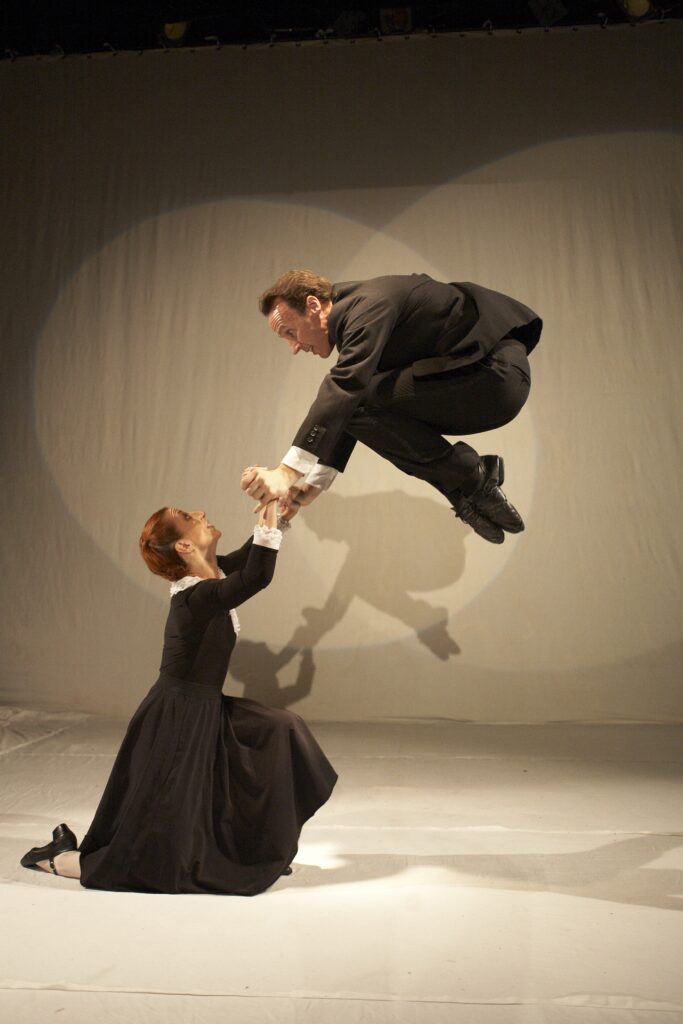Nathan Cottam is a performing artist devoted to broadening the scope of people involved in dance and theater. Raised in Buffalo, New York and the Mountain West, Nathan was exposed early in life to music and drama, finally joining them together in the study of ballet at Brigham Young University. After completing a BS in sociology, Nathan went on to earn a Master of Fine Art in Dance from the University of Arizona. In 2008 he moved to San Francisco, California and danced for Peninsula Ballet Theatre and Oakland Ballet before leaping across the Atlantic to join the Serbian National Ballet. He remains the only non-Serbian to dance the lead role in Ko To Tamo Peva (Who is Singing Over There?) the signature work of the National Theater in Belgrade.
In 2013 Nathan founded Mannakin Theater & Dance while still living in Serbia, and produced his first full evening performance at the REX Cultural Center, Belgrade. Two tours of Serbia followed, with support from the US Embassy. August of 2016 saw his first full production on home soil, at San Francisco’s Palace of the Legion of Honor.
In the summer of 2017 Nathan traveled to Bulgaria to work with children of refugee families from Syria and Afghanistan, thus initiating outreach efforts of Mannakin Theater & Dance. He returned to Bulgaria in 2018 and plans to do so again. In April of 2018, he founded en Avant School, a classical ballet academy with a mission to bring high level ballet training to underserved youth in East Palo Alto and other parts of the Peninsula. Children from the school participate annually in The Nutshell!
The Nutshell! was conceived in October of 2017 and was seen in its first iteration just two months later. Nathan brought kids from the local Boys and Girls Club to the theater with no prior rehearsal, and put them on stage just an hour later as mice and soldiers in the Nutcracker Battle. It worked like a charm and has grown steadily ever since. In the 2020 film version of the Nutshell! more than 400 performers will be seen in four unique casts. They will present original choreography created just for The Nutshell! by over 50 companies, on five continents.

Tell us a little about yourself and the creation of your theater company?
Nathan Cottam: Theater and drama were always part of my life, music too, but it took quite some time to add dance and complete cocktail that makes up my company, Mannakin Theater & Dance.
As I was growing up, my mother would fill the house with music. She is a wonderful pianist, so I have poignant memories of drifting off to sleep with her playing Mozart, Beethoven and Chopin. Anytime she was just about the house doing things she would be playing records on an enormous stereo system. I couldn’t have been more than four years old, but I remember the day that stereo arrived at our house because it was so important to my mother. From then on it was a centerpiece in our home, no matter where we went. It was the size of a couch, a real piece of furniture made of nicely finished, dark wood. One time, at about six years old and alone in the room, I stood in front of it as Beethoven’s Fifth came soaring out of the speakers and pretended to conduct the orchestra. Or maybe I just danced, but I remember that moment and I remember by mother seeing me and the smile that came over her.
My family always entertained in one way or another. My parents organized a Christmas show every year that we took around to retirement homes or church parties or anything of that sort. We had a whole program that went along with the songs, for one song it was a set of large cards that my five siblings and I would hold up one at a time to spell out CHRISTMAS. For Rudolph the Red Nosed Reindeer my father had created a glowing nose out of a ping pong ball that was painted red with a light bulb inside. Wires connected it to a battery the size of a brick that I would hold behind my back when it was my turn to be “Rudolph.” This rig was so cumbersome to put on due to all the straps that held it on to your head but the crowds loved it. I remember that you had to manually blink the light by clicking a connection on the battery. Funny to think how simple it would be to do something like that today.
My parents were also a team in drama. My father wrote quite a few plays that my mother would direct. Many of these took place when we lived in Wyoming. Red Desert Dan and another play about how Santa ended up using Jackalopes to pull his sleigh instead of reindeer one year. (Jackalopes are a fantastical animal that is close to the hearts of Wyoming Cowboys.) My father also wrote a lot of poetry. For any occasion, big or small you could expect a poem written by my Dad. He didn’t seem like a creative person when you would meet him, but he was intensely creative. He would always joke that he couldn’t tell the different between Tolstoy and a dime store novel, but I never believed him.
I studied the trumpet and the French horn through high school and a little beyond and was involved in plays and musicals all the time. One of my favorites was A Midsummer Night’s Dream, directed by my good friend Therese Henning. My costume was incredible! Gold lamé pants with a matching cape, combat boots, drawings all over my chest and a crown of twigs and branches!
In 1997 I arrived at Brigham Young University and took a beginning ballet class because the school was no longer offering fencing classes and I didn’t fancy any of the other physical education classes. I can’t say ballet was love at first sight for me, because it took quite a while before I felt like I was a dancer, many years, in fact. Ballet and dance were something that I understood, though, somehow. At first it was mostly because with ballet you can sink your teeth in as deep as you can imagine and will still take you years to reach the bone. When you’re in the ballet classroom there is a clear path for one to direct all the energy one has, and I took advantage of that. One of my early teachers said that he had never seen someone work as hard as I do. Another admitted that I loved it more than he did.
What inspired the international project The Nutshell!
Nathan Cottam: It was just such an obvious pathway when I decided to do The Nutshell! on film. Anytime you work in a given medium, you have to overcome the obstacles unique to that medium by using its inherent strengths. One of the great strengths of the film medium is that you can bring the world to anyone’s living room or cell phone, even in the time of the pandemic. In fact, it’s especially important to do so during the pandemic to help people fell a little unity in this time of stress. That’s what is so important about art. I like to think that art is not an imitation of life, per se, but that it’s a reaction to life—a view of what this moment of life is, or was, through the lens of a particular artist. In the case of this year’s Nutshell the art was literally captured by the lenses of more than dozens of cameras, held by nearly as many filmmakers and directors. The concept came from me, but the work now exists because of a chorus of artists around the world. And this in a time when people are hungering for connection in their lives, many of us like never before. So when I decided not to give up on a 2020 version of The Nutshell! the international aspect of it was unavoidable. The task became only getting people on board, which was a lot of calling and emailing and searching, but from the first moment to the last I was met with enthusiasm at every turn.
A final note on the Nutcracker itself regarding the international nature of my current project is that The Nutcracker is already international in so many ways. The entire second act is a journey from Spain to China through the Arab world, Russia, France and…wherever it is they make gingerbread, probably Switzerland…That and the simple fact that The Nutcracker is international. It’s played everywhere and is known nearly everywhere on the planet. That the Nutcracker is already shared so broadly across cultures is why The Nutshell! works as a stand-alone film.

What is your favorite play?
Nathan Cottam: Cool Hand Luke—I know that’s not a play, but it should be!
OK, favorite play would have to be Death of a Salesman. But this is a very hard choice. I am drawn to tragedies, in both the technical and colloquial sense. They, like nothing else show the preciousness of life and make me want to do everything I ever dream of doing, and right away.
What about your favorite production to direct?
Nathan Cottam: I mostly direct things that I write or have a strong hand in creating from stage one. That’s not because of any aversion to directing a classic or a work that comes to me fully formed. It just has happened this was so far. In a way, working on brand new things is much easier because it’s fresh snow and you don’t have to worry about the shape of the tracks that were laid before you. Even restaging some of my own works, which I have done more than a few times, is very challenging. Rewarding, but challenging.
With all this in mind, I’ll answer this question with my own ballet, called Elements of Permutation. It’s the first piece of mine that I ever restaged. And even though it is a dance with no speaking at all, there is a great deal of character that goes into the different dancers. Enough so that I can confidently call them actors.
Top 3 favorite projects you have been involved in?
- All Men—My all-male homage to La Bayadere entrance of the Shades.
- The Nutshell!—Every year, but 2020 in particular
- Ko To Tamo Peva? (Who is Singing Over There?)—Ballet based on the Serbian movie. I am the only non-Serbian to dance the lead male role of the singer. Incredible work of art.
What qualities do you seek in an actor you work with?
Nathan Cottam: The ability to exist in and embrace chaos. I think some of the greatest and most worthy beauty is borne of chaos, and regard it as a necessity in the creative process. So, I like working with people who can tolerate and even thrive in that when those moments come. Who handles stress well and still clearly wants to be in the room and part of the process—that’s who I like working with.
What skills/personal attributes are most important to being successful?
Nathan Cottam: Hard work and showing up. It all comes down to those two things. And luck, of course. If one can just be lucky all the time you don’t need hard work, and you probably don’t even need to show up. So, if you can’t guarantee a never-ending and uninterrupted string of good luck, you had better fall back on hard work and showing up.
What do you consider your biggest accomplishment to date?
Nathan Cottam: In 2010 I created a parody of a work that was performed on the very same program as the premiere of that work. I joke with my friend, Charles, who made the source work (I didn’t tell him about my parody before it went on stage) that he is probably the only artist in history who had a work parodied fifteen minutes after it premiered—from the same stage and before the same audience. Madonna and Michael Jackson had to wait many years to receive the same treatment from Weird Al Yankovic! The piece itself was no great feat, but I regard the fact that I followed my gut in that instance as one of the boldest and, indeed, defining moments of my career.

What do you enjoy most about your job, your career?
Nathan Cottam: Literally everything. The challenges are there, but you learn to even enjoy them. You have to because you will never avoid them. If you get past one, you are just going to meet another. As it should be. If there is nothing to push against…I don’t know what happens. That’s not to say there needs to be great struggle in all things, there need not, so maybe it’s better to look at challenges as things we must react to. If there is nothing to react to…I don’t know what happens. Hmmm, there are problems with that statement too, because I am not one who believes that there is no such thing as an original thought. There certainly IS such a thing as an original thought, it’s just rare.
Anyway, the point is, I enjoy everything about my job, even the things that present a challenge. Especially the things that present a challenge because they are most often the source of creativity and, dare I say, an original thought.
Do you express yourself creatively in any other ways?
Nathan Cottam: I love woodworking! I’m not that good at it, but I love doing it. If I had more time and space on my hands, that is what I would choose to do more of.
Is there any advice you would give to a young actor starting their career?
Nathan Cottam: Don’t quit until it’s time. Only you will know when that time comes, but until does, work your art and craft with savagery. Don’t waste a moment. Take in every voice that comments on what you do and how you are living, but only hold on to the ones that empower and push you onward. People look at our lives and careers as dancers and actors in a strange way—I think a lot of people wish they could have done this, and they think our lives are a constant dream. And a lot of young actors and dancers think the same way, that it will be dream come true. It will only be like that some of the time, but those times are well worth the work and persistence.
What’s your goal for next year?
Nathan Cottam: There are so many projects I want to accomplish. For many years I’ve wanted to complete a ballet I started years ago, while living in Belgrade. It’s called Gracefully Existent and it is a portrayal of the responsibility/burden that women bear in evolving/preserving culture through their dress. I presented an excerpt of it at the Sterijino Pozorje Drama Festival in 2013 and have wanted to return to it ever since.
What’s next for your theater company Mannakin Theater & Dance?
Nathan Cottam: I’ve mostly talked about dance in responding to your questions, but I do direct drama as well, though not yet with Mannakin Theater & Dance. The next step for my company is to bring more of what we think of as drama and acting into the rep. I’ve always wanted to take a classic play and portray the first act in “normal” fashion, with speaking and stage actors, and then the second act with dancers.
One other project I’d like to complete with Mannakin is a one man show that takes the audience on the journey I made in departing from the Mormon Church. This would be a hybrid program that involves dance and dialogue, perhaps film as well.

Views: 212






